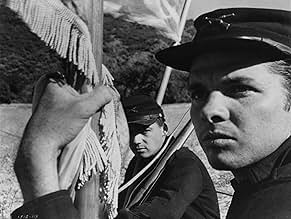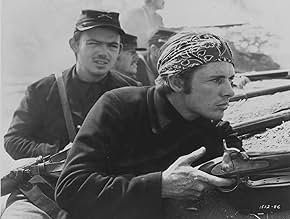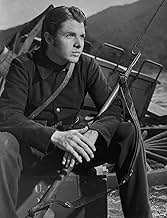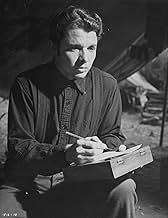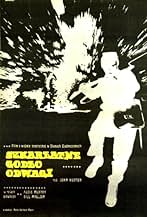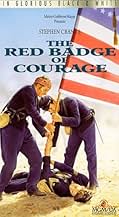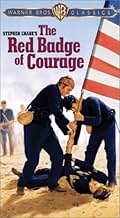VALUTAZIONE IMDb
7,1/10
5181
LA TUA VALUTAZIONE
Un adattamento troncato dell'omonimo romanzo di Stephen Crave su un soldato dell'Unione durante la Guerra Civile che fatica a trovare il coraggio per combattere nel cuore della battaglia.Un adattamento troncato dell'omonimo romanzo di Stephen Crave su un soldato dell'Unione durante la Guerra Civile che fatica a trovare il coraggio per combattere nel cuore della battaglia.Un adattamento troncato dell'omonimo romanzo di Stephen Crave su un soldato dell'Unione durante la Guerra Civile che fatica a trovare il coraggio per combattere nel cuore della battaglia.
- Regia
- Sceneggiatura
- Star
- Nominato ai 1 BAFTA Award
- 2 vittorie e 1 candidatura in totale
Robert Easton
- Thompson
- (as Robert Easton Burke)
Don Anderson
- Soldier
- (non citato nei titoli originali)
Smith Ballew
- Union Captain
- (non citato nei titoli originali)
Albert Band
- Union Soldier Fording River
- (non citato nei titoli originali)
Gregg Barton
- Soldier
- (non citato nei titoli originali)
Whit Bissell
- Wounded Officer
- (non citato nei titoli originali)
Robert Board
- Soldier
- (non citato nei titoli originali)
Chet Brandenburg
- Wounded Soldier
- (non citato nei titoli originali)
Edwin Breen
- Confederate Flag Bearer
- (non citato nei titoli originali)
Joe Brown Jr.
- Soldier
- (non citato nei titoli originali)
Recensioni in evidenza
I can't understand why this movie isn't more well known or why it doesn't get more critical applause. Well, I suppose it's in black and white, it's short, it has no expensive bankable stars, and no love interest. I can't think of any other reasons, because this is a very good movie indeed. John Huston's direction is outstanding, while still being understated. When he was uninterested, Huston could do a merely pedestrian job. But he must have been interested in "The Red Badge of Courage," from beginning to end.
Example from the beginning: a group of soldiers are gathered around a speaker who is spreading rumors about a coming battle, most of their backs turned to us. The camera slowly moves in towards the small crowd, not the speaker, but the backs of the listeners' heads, and one of the soldiers turns around towards the camera and steps quickly into a close up with an expression of deep self-doubt. What a way to introduce Audie Murphy as Henry Fleming! What a way to individuate a mob of naive young men!
Example from the end: Henry and his friend Tom, played by Bill Mauldin, are marching away from the battlefield, still alive, and a bit surprised. Tom says something about how the birds are beginning to sing again, and Henry agrees that as soon as the smoke and noise of battle end it doesn't take the birds long to get worked up again. Henry looks upward over his shoulder, and Huston gives us a point-of-view shot of a hazy sun drifting dimly through the tops of the trees that tower alongside the road. The cast could hardly do better. It is Audie Murphy's best performance by far. In "To Hell and Back," in which he played himself, he wasn't required to do much more than rudimentary acting, and the film itself is cliché ridden. Here, Murphy convinces us that he's worried, or scared, or hijacked by his amygdala, or whatever the situation calls for. His boyish voice is completely appropriate to the role, as is his overall appearance. He seems to have really given this movie some effort. Bill Mauldin as Tom is also surprisingly good. He was undoubtedly the most famous and most controversial cartoonist of World War II and spent a good deal of time with Murphy's Third Division in Italy. He may not be a trained actor, but his sincerity, his gawky face and outlandish ears are more convincing than, say, Tab Hunter's brawn ever was. All of the supporting cast are excellent, particularly John Dierkes as the dying soldier.
Do you want to have your hair raised? Read Steven Crane's original novel. He was 22 when he wrote it, years after the Civil War had ended, but no one would know it from the novel, which has the ring of reminiscence about it. The scene of the dying soldier as he actually dies, standing and trembling from head to foot as if in some Jacksonian fit, is unforgettable in its horror. It's impossible to identify the battle on which the book was based, if indeed there was any.
Let's face facts. The North lost damned near all of its most dramatic battles, and not through the fault of its soldiers or junior officers. (General Winterside's cognomen must have been influenced by the real-life General Ambrose Burnside, for whom our "sideburns" are named. Burnside was one of Lincoln's worst generals and had the good sense and the courage to admit it himself.} The Penninsular campaign, fought under MacLellan, another real hard-charging fire eater, was a dismal failure and ended in an ignominious retreat Crane was from New Jersey and is now buried in Evergreen Cemetery in Hillside, having died a young man. One can only wonder what he might have accomplished had he written more than just two novels. The photography may be black and white but it's splendidly done. I find the only two problems, and they're relatively minor ones, involve the production itself. This isn't back East where the war was fought. This is clearly California, with scattered live oak trees dark and evergreen against the dried summer bunch grass. And the musical score is generic, adding little to the picture aside from the expected Battle Hymn of the Republic and triumphant marches in major keys. A fine picture, all around.
Example from the beginning: a group of soldiers are gathered around a speaker who is spreading rumors about a coming battle, most of their backs turned to us. The camera slowly moves in towards the small crowd, not the speaker, but the backs of the listeners' heads, and one of the soldiers turns around towards the camera and steps quickly into a close up with an expression of deep self-doubt. What a way to introduce Audie Murphy as Henry Fleming! What a way to individuate a mob of naive young men!
Example from the end: Henry and his friend Tom, played by Bill Mauldin, are marching away from the battlefield, still alive, and a bit surprised. Tom says something about how the birds are beginning to sing again, and Henry agrees that as soon as the smoke and noise of battle end it doesn't take the birds long to get worked up again. Henry looks upward over his shoulder, and Huston gives us a point-of-view shot of a hazy sun drifting dimly through the tops of the trees that tower alongside the road. The cast could hardly do better. It is Audie Murphy's best performance by far. In "To Hell and Back," in which he played himself, he wasn't required to do much more than rudimentary acting, and the film itself is cliché ridden. Here, Murphy convinces us that he's worried, or scared, or hijacked by his amygdala, or whatever the situation calls for. His boyish voice is completely appropriate to the role, as is his overall appearance. He seems to have really given this movie some effort. Bill Mauldin as Tom is also surprisingly good. He was undoubtedly the most famous and most controversial cartoonist of World War II and spent a good deal of time with Murphy's Third Division in Italy. He may not be a trained actor, but his sincerity, his gawky face and outlandish ears are more convincing than, say, Tab Hunter's brawn ever was. All of the supporting cast are excellent, particularly John Dierkes as the dying soldier.
Do you want to have your hair raised? Read Steven Crane's original novel. He was 22 when he wrote it, years after the Civil War had ended, but no one would know it from the novel, which has the ring of reminiscence about it. The scene of the dying soldier as he actually dies, standing and trembling from head to foot as if in some Jacksonian fit, is unforgettable in its horror. It's impossible to identify the battle on which the book was based, if indeed there was any.
Let's face facts. The North lost damned near all of its most dramatic battles, and not through the fault of its soldiers or junior officers. (General Winterside's cognomen must have been influenced by the real-life General Ambrose Burnside, for whom our "sideburns" are named. Burnside was one of Lincoln's worst generals and had the good sense and the courage to admit it himself.} The Penninsular campaign, fought under MacLellan, another real hard-charging fire eater, was a dismal failure and ended in an ignominious retreat Crane was from New Jersey and is now buried in Evergreen Cemetery in Hillside, having died a young man. One can only wonder what he might have accomplished had he written more than just two novels. The photography may be black and white but it's splendidly done. I find the only two problems, and they're relatively minor ones, involve the production itself. This isn't back East where the war was fought. This is clearly California, with scattered live oak trees dark and evergreen against the dried summer bunch grass. And the musical score is generic, adding little to the picture aside from the expected Battle Hymn of the Republic and triumphant marches in major keys. A fine picture, all around.
Although John Huston's The Red Badge of Courage has stood the test of time critically, back then it lost lots of money in its first release. The film was a bone of contention between Louis B. Mayer and Dore Schary who were locked in a power struggle for control at Metro-Goldwyn- Mayer. Schary wanted to make the film, Mayer said it would flop and he was proved right. He also got ousted anyway.
The Red Badge of Courage refers to the blood that gets spilled should you sustain a battle wound. If you remember in Oliver Stone's Platoon, the men don't treat new arrival Charlie Sheen until he's gotten one of those. Here the Red Badge is something to be avoided if possible.
By a piece of serendipity when Audie Murphy returned from World War II and was deciding on a career, he chose the movies. He certainly was loaded down with offers, but I guess he sensed in himself an inner gift for being an actor. Not Marlon Brando or Laurence Olivier, but someone in the hands of the right director could get a good performance out of him. In John Huston he found that director, twice in fact as he later worked with him in The Unforgiven.
There was no need for research because our most decorated soldier in history lived the research in North Africa and Europe. There's a dimension to Audie's performance and that of GI cartoonist Willard Mullin that no training at the Actor's Studio could have given them. Murphy just summoned his memories of what it was like to be a kid from Texas whisked off to Europe the way young Henry Fleming is facing the Confederates in their backyard.
Murphy gets good support from an able cast of people like Arthur Hunnicutt, Royal Dano, John Dierkes, and Andy Devine as various other soldiers in the Union Army, all citizens serving their country. No career people in this crowd. Also James Whitmore, reading the narrative of Stephen Crane's novel serves almost like another cast member and moves the film's story line along.
Though it lost money for MGM, The Red Badge of Courage is still a fine film with some great insights into the meaning of battlefield bravery.
The Red Badge of Courage refers to the blood that gets spilled should you sustain a battle wound. If you remember in Oliver Stone's Platoon, the men don't treat new arrival Charlie Sheen until he's gotten one of those. Here the Red Badge is something to be avoided if possible.
By a piece of serendipity when Audie Murphy returned from World War II and was deciding on a career, he chose the movies. He certainly was loaded down with offers, but I guess he sensed in himself an inner gift for being an actor. Not Marlon Brando or Laurence Olivier, but someone in the hands of the right director could get a good performance out of him. In John Huston he found that director, twice in fact as he later worked with him in The Unforgiven.
There was no need for research because our most decorated soldier in history lived the research in North Africa and Europe. There's a dimension to Audie's performance and that of GI cartoonist Willard Mullin that no training at the Actor's Studio could have given them. Murphy just summoned his memories of what it was like to be a kid from Texas whisked off to Europe the way young Henry Fleming is facing the Confederates in their backyard.
Murphy gets good support from an able cast of people like Arthur Hunnicutt, Royal Dano, John Dierkes, and Andy Devine as various other soldiers in the Union Army, all citizens serving their country. No career people in this crowd. Also James Whitmore, reading the narrative of Stephen Crane's novel serves almost like another cast member and moves the film's story line along.
Though it lost money for MGM, The Red Badge of Courage is still a fine film with some great insights into the meaning of battlefield bravery.
Those who think Audie Murphy was not a very good actor haven't seen him in this film. Perhaps some of his later Western films didn't give him as much to work with, but in Red Badge of Courage he shines. Just a few of many great scenes which come to mind: early in the film when he hears that his group will finally be going into action, he writes a letter to his pa 'in case you are told that I have fallen', and you can see the remains of tears drying on his face; later on when his friend Jim dies after the first real battle, in Murphy's reaction you can see how wrenching it is for him to realize the human cost of war. Bill Mauldin, the famous cartoonist, plays the role of Murphy's closest friend in his fighting group, and does a superb job as well. Both Murphy and Mauldin seem perfectly suited to the age of their characters. While they were not originally actors by trade and had little if any acting experience, their performances in this film should shame many of today's 'actors' who draw multi million dollar paychecks and whose 'work' pales in comparison to that of Murphy and Mauldin in this film.
My only real disappointment was that due to massive editing the film is only 69 minutes long! I figured it was at the midway point when 'the end' came on the screen. Apparently this film became a sort of political football within the studio when it was made, yet I can't understand how anyone could justify cutting it down to this length. I was thoroughly enjoying this film all the way through and was nowhere near ready for it to end. Even so, even if you're not a Civil War buff, this is an excellent film with very engaging performances. It's more about the people than it is the war. Highly recommended.
My only real disappointment was that due to massive editing the film is only 69 minutes long! I figured it was at the midway point when 'the end' came on the screen. Apparently this film became a sort of political football within the studio when it was made, yet I can't understand how anyone could justify cutting it down to this length. I was thoroughly enjoying this film all the way through and was nowhere near ready for it to end. Even so, even if you're not a Civil War buff, this is an excellent film with very engaging performances. It's more about the people than it is the war. Highly recommended.
stephen crane's best work. audie murphy's best work. any serious student of the civil war will recognize this film as the best, most honest portrayal of civil war action. it captures the fear and dread of deadly combat like no other film on the american civil war. during bloody battles, if your side was not having a successful day, the usual way out was "skedaddling" or running like the wind. both sides did it. a great little film that all civil war students and scholars should own and view every so often.
Such a darn shame so much of the film was lost during a power struggle at MGM. What remains is a strong drama adapted from the Crane novel. Some call it an anti-war film, but that's a stretch since Audie Murphy's youthful soldier proves himself in battle after a cowardly initiation, and receives the admiration of his buddies. The sequence is more like a rite of passage than a denunciation.
The somewhat amateur cast is outstanding. I expect the untrained Murphy felt a personal commitment to his role and comes through just as professionally as he did in real life. Untrained cartoonist Bill Mauldin also looks and acts the part of callow youth maturing under pressures of life or death situations. His big ears are especially persuasive for a Hollywood setting.
And what burst of inspiration led the normally glamor-obsessed Tiffany of Studios to cast such affecting unlovelies as John Dierkes and Royal Dano in key parts. It's Dierkes's ill-fated salt-of-the-earth soldier that injects real tragedy into the sparse dialogue. With his craggy face and towering body he's every inch the early American primitive. And, of course, there's Dano with his gaunt face, wasted body, and graveyard voice, who helps make that line of wounded soldiers (the real core of the film) an unforgettable procession. Nor should that genuine face of war, the battle-shocked soldier deliriously bellowing The Battle Hymn of the Republic as he trudges along, be overlooked. And for a little humorous relief, who can forget the general whose pep-talk to each unit sounds like a broken record with a big stomach, but whose humanity shines through anyway.
The sweeping battlefields are effective in their look and feel, even if it is the scrublands of SoCal in the distance. Note all the dust and smoke obscuring vision, along with the chaotic criss-crossing of other units going here and there, but we don't know where. The effect is that of focusing our concerns on the familiar faces rather than on who's winning or losing the battle, which, I gather, is the way most infantry experience battle. It's been called understandably "the fog of war".
I like the brief lyrical moments that remind us of a larger world outside the stage of human conflict. Actually, Murphy is quite good at portraying sensitivity, as for example when he turns away from the raucous byplay at the farm house. The quiet moments with him and Mauldin are rather touching in that they look like two average Joe's showing the personal side of war. But, as Murphy proved in both the movie and real life, you never know the depths that may be concealed under that ordinary appearance.
I believe it was critic Andrew Sarris who pointed out that John Huston's career was never the same after MGM got through editing out an hour of his version and throwing the rest away. Now we can only guess how many other affecting scenes were tossed out in the process. Obviously, the project was close to Huston's heart being an adaptation of a great American novel from its most wrenching national conflict. I don't know whether to be happy or sad that this severely truncated version was finally marketed. It's good, but then there's the promise of so much more. Too bad the production didn't migrate to a less image-conscious studio.
The somewhat amateur cast is outstanding. I expect the untrained Murphy felt a personal commitment to his role and comes through just as professionally as he did in real life. Untrained cartoonist Bill Mauldin also looks and acts the part of callow youth maturing under pressures of life or death situations. His big ears are especially persuasive for a Hollywood setting.
And what burst of inspiration led the normally glamor-obsessed Tiffany of Studios to cast such affecting unlovelies as John Dierkes and Royal Dano in key parts. It's Dierkes's ill-fated salt-of-the-earth soldier that injects real tragedy into the sparse dialogue. With his craggy face and towering body he's every inch the early American primitive. And, of course, there's Dano with his gaunt face, wasted body, and graveyard voice, who helps make that line of wounded soldiers (the real core of the film) an unforgettable procession. Nor should that genuine face of war, the battle-shocked soldier deliriously bellowing The Battle Hymn of the Republic as he trudges along, be overlooked. And for a little humorous relief, who can forget the general whose pep-talk to each unit sounds like a broken record with a big stomach, but whose humanity shines through anyway.
The sweeping battlefields are effective in their look and feel, even if it is the scrublands of SoCal in the distance. Note all the dust and smoke obscuring vision, along with the chaotic criss-crossing of other units going here and there, but we don't know where. The effect is that of focusing our concerns on the familiar faces rather than on who's winning or losing the battle, which, I gather, is the way most infantry experience battle. It's been called understandably "the fog of war".
I like the brief lyrical moments that remind us of a larger world outside the stage of human conflict. Actually, Murphy is quite good at portraying sensitivity, as for example when he turns away from the raucous byplay at the farm house. The quiet moments with him and Mauldin are rather touching in that they look like two average Joe's showing the personal side of war. But, as Murphy proved in both the movie and real life, you never know the depths that may be concealed under that ordinary appearance.
I believe it was critic Andrew Sarris who pointed out that John Huston's career was never the same after MGM got through editing out an hour of his version and throwing the rest away. Now we can only guess how many other affecting scenes were tossed out in the process. Obviously, the project was close to Huston's heart being an adaptation of a great American novel from its most wrenching national conflict. I don't know whether to be happy or sad that this severely truncated version was finally marketed. It's good, but then there's the promise of so much more. Too bad the production didn't migrate to a less image-conscious studio.
Lo sapevi?
- QuizAfter seeing what MGM had done to the film, John Huston instructed his agent to include a clause in all future contracts guaranteeing that he would receive a copy of his director's cut on all of his films.
- BlooperBeginning at 14:28, several Union soldiers wading across the waist-deep river and later climbing out of the river are carrying the U.S. Rifle Model 1903, also known as the Springfield Model 1903. Note especially the soldier who climbs out of the river holding his rifle above his head. The Model 1903 is a bolt-action, magazine-fed rifle that was adopted by the US Army in 1903 and used in World Wars I and II, but not the American Civil War which was fought from 1861-1865.
- Citazioni
The General: Howdy Jim, Corporal. How are those wounds?
Soldier: Stinging some, General, but they're a-mending.
The General: That's fine, fine. Anybody care for a chaw?
- ConnessioniEdited into Hollywood: The Dream Factory (1972)
I più visti
Accedi per valutare e creare un elenco di titoli salvati per ottenere consigli personalizzati
- How long is The Red Badge of Courage?Powered by Alexa
Dettagli
Botteghino
- Budget
- 1.640.000 USD (previsto)
- Tempo di esecuzione
- 1h 9min(69 min)
- Colore
- Proporzioni
- 1.37 : 1
Contribuisci a questa pagina
Suggerisci una modifica o aggiungi i contenuti mancanti


